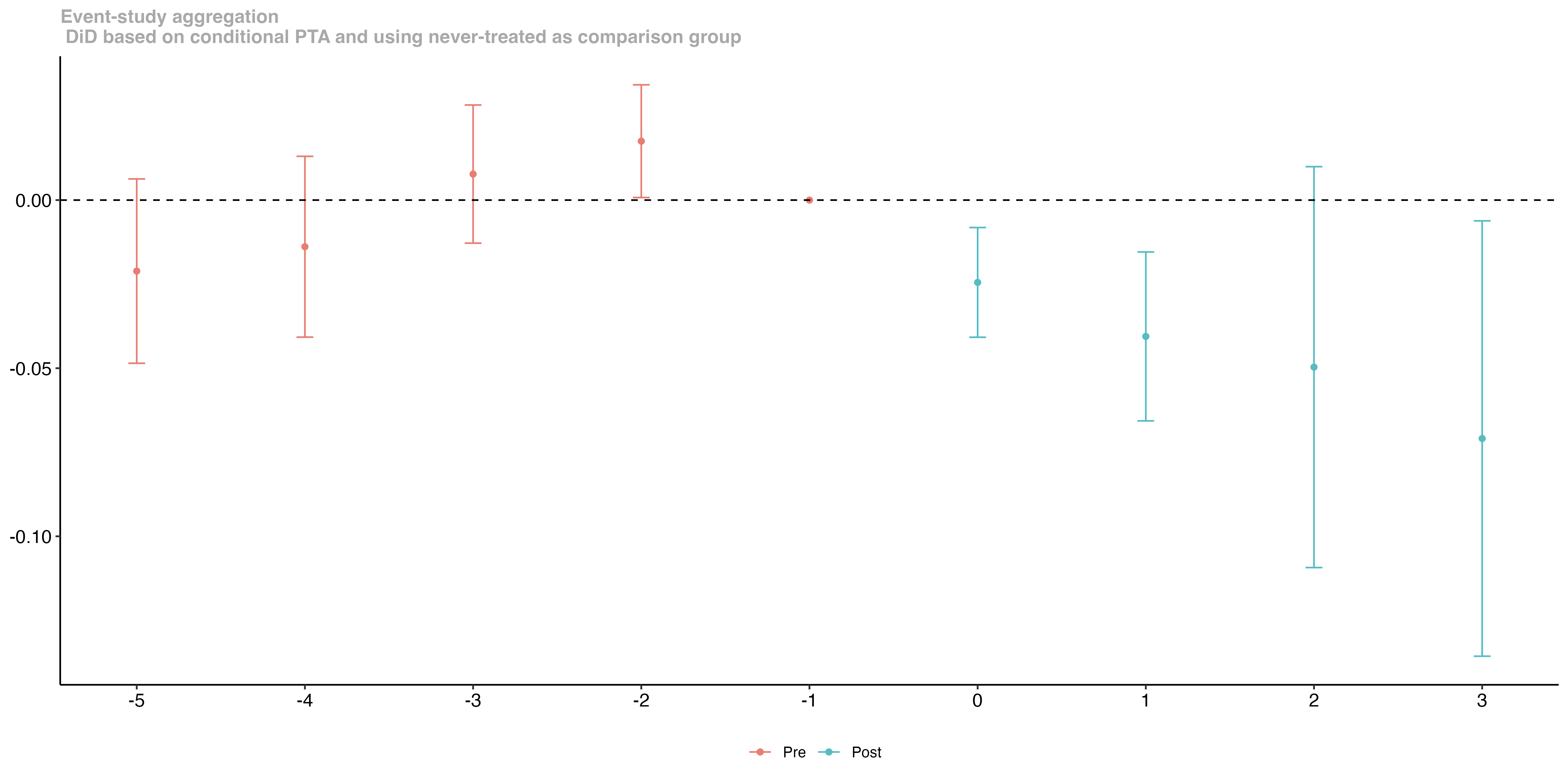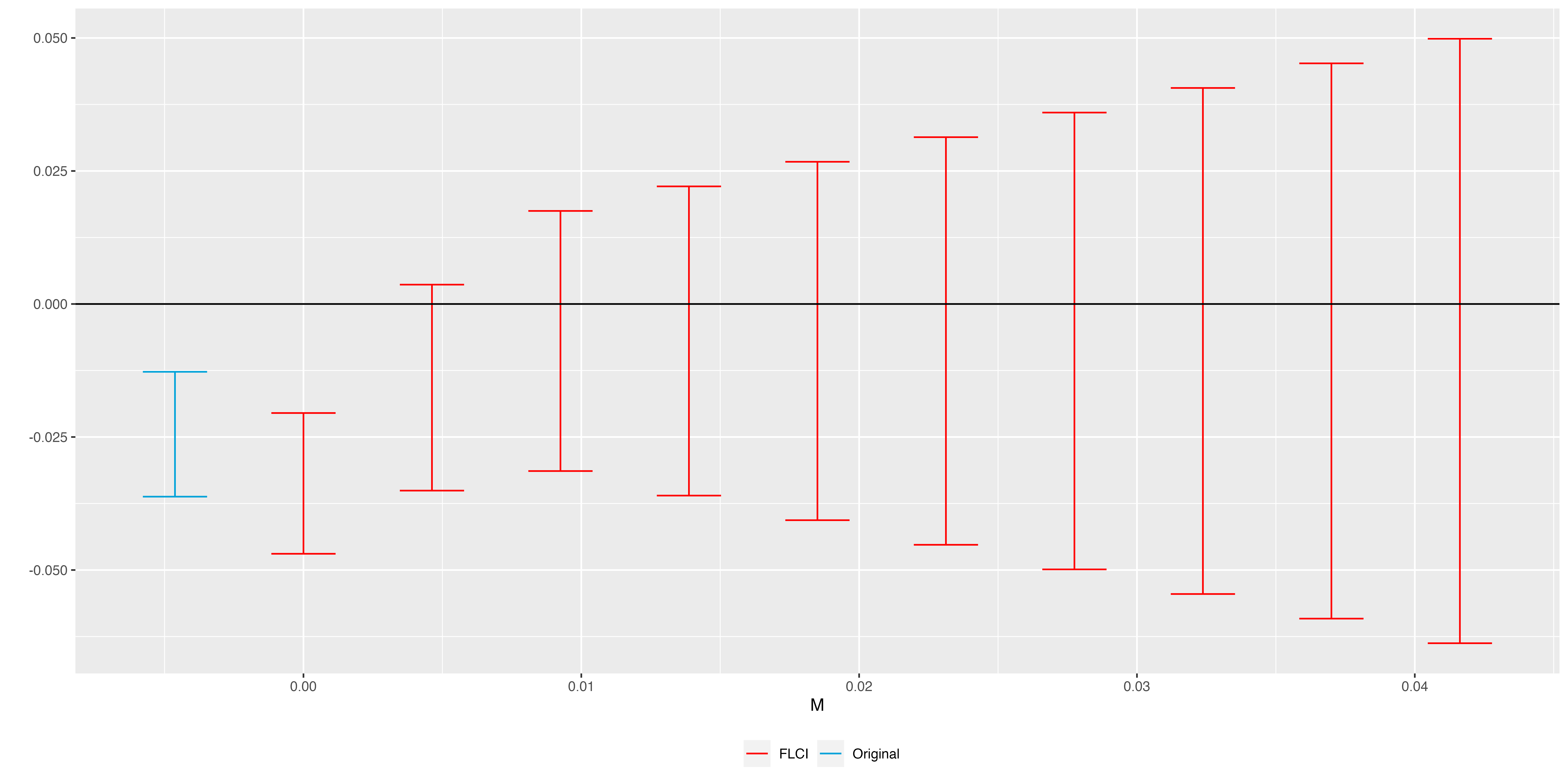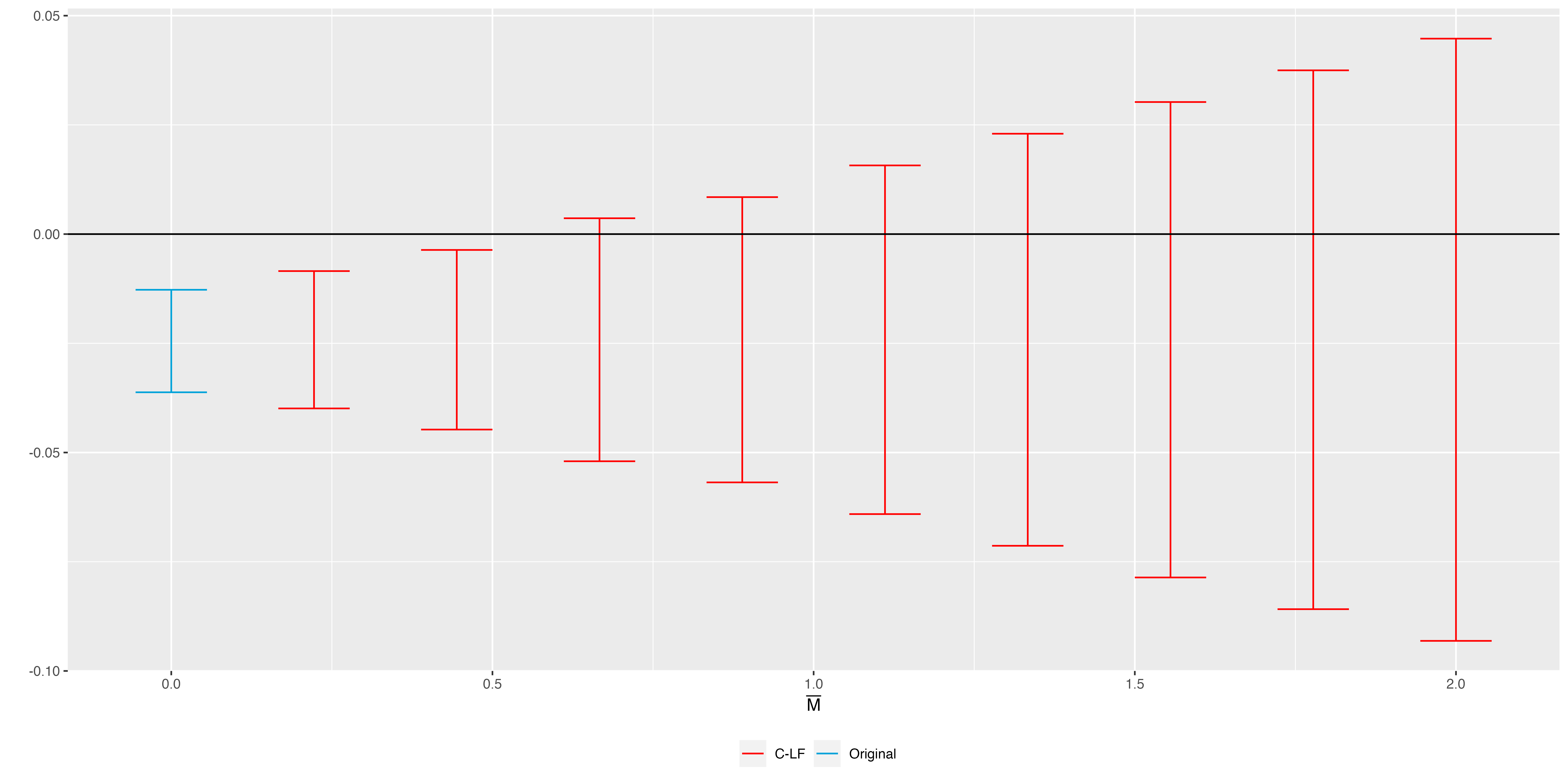Sensitivity Analysis for Heterogeneity-Robust DiD Procedures: Combining Callaway and Sant’Anna (2021) with Rambachan and Roth (2022)
The main goal of this repository is to illustrate how one can combine
the heterogeneity-robust Difference-in-Differences procedures proposed
by Callaway and Sant’Anna (2021) with the sensitivity analysis tools for
potential violations of parallel trends proposed by Rambachan and Roth
(2022). These are currently implemented in the did and HonestDiD R
packages.
Towards that end, we will use the empirical application considered in Callaway and Sant’Anna (2021) about the effect of minimum wage on teen employment.
Before we jump into details, let’s install and load some the necessary R packages to run the example.
# Install some packages
library(devtools)
install_github("bcallaway11/BMisc", dependencies = TRUE)
install_github("bcallaway11/did", dependencies = TRUE)
install_github("asheshrambachan/HonestDiD", dependencies = TRUE)
#--------------------------------------------------------------------------
# Load packages
#--------------------------------------------------------------------------
# Libraries
# Load libraries
library(ggplot2)
library(here)
library(foreign)
library(tidyverse)
library(dplyr)
library(did)
library(HonestDiD)Since this integration is still a work-in-progress and has not yet been
merged into neither the did nor the HonestDiD R packages, let’s
define some auxiliary functions that will help implementing it.
#' @title honest_did
#'
#' @description a function to compute a sensitivity analysis
#' using the approach of Rambachan and Roth (2021)
honest_did <- function(...) UseMethod("honest_did")
#' @title honest_did.AGGTEobj
#'
#' @description a function to compute a sensitivity analysis
#' using the approach of Rambachan and Roth (2021) when
#' the event study is estimating using the `did` package
#'
#' @param e event time to compute the sensitivity analysis for.
#' The default value is `e=0` corresponding to the "on impact"
#' effect of participating in the treatment.
#' @param type Options are "smoothness" (which conducts a
#' sensitivity analysis allowing for violations of linear trends
#' in pre-treatment periods) or "relative_magnitude" (which
#' conducts a sensitivity analysis based on the relative magnitudes
#' of deviations from parallel trends in pre-treatment periods).
#' @inheritParams HonestDiD::createSensitivityResults
#' @inheritParams HonestDid::createSensitivityResults_relativeMagnitudes
honest_did.AGGTEobj <- function(es,
e = 0,
type = c("smoothness", "relative_magnitude"),
gridPoints = 100,
...) {
type <- match.arg(type)
# Make sure that user is passing in an event study
if (es$type != "dynamic") {
stop("need to pass in an event study")
}
# Check if used universal base period and warn otherwise
if (es$DIDparams$base_period != "universal") {
stop("Use a universal base period for honest_did")
}
# Recover influence function for event study estimates
es_inf_func <- es$inf.function$dynamic.inf.func.e
# Recover variance-covariance matrix
n <- nrow(es_inf_func)
V <- t(es_inf_func) %*% es_inf_func / n / n
# Remove the coefficient normalized to zero
referencePeriodIndex <- which(es$egt == -1)
V <- V[-referencePeriodIndex,-referencePeriodIndex]
beta <- es$att.egt[-referencePeriodIndex]
nperiods <- nrow(V)
npre <- sum(1*(es$egt < -1))
npost <- nperiods - npre
baseVec1 <- basisVector(index=(e+1),size=npost)
orig_ci <- constructOriginalCS(betahat = beta,
sigma = V,
numPrePeriods = npre,
numPostPeriods = npost,
l_vec = baseVec1)
if (type=="relative_magnitude") {
robust_ci <- createSensitivityResults_relativeMagnitudes(betahat = beta,
sigma = V,
numPrePeriods = npre,
numPostPeriods = npost,
l_vec = baseVec1,
gridPoints = gridPoints,
...)
} else if (type == "smoothness") {
robust_ci <- createSensitivityResults(betahat = beta,
sigma = V,
numPrePeriods = npre,
numPostPeriods = npost,
l_vec = baseVec1,
...)
}
return(list(robust_ci=robust_ci, orig_ci=orig_ci, type=type))
}Now, let’s load the data used in Callaway and Sant’Anna (2021)
# Load data used in Callaway and Sant'Anna (2021) application
min_wage <- readRDS((here("data",'min_wage_CS.rds')))Now, let’s compute the event-study plot using the Doubly-Robust DiD procedure of Callaway and Sant’Anna (2021) based on the ``never-treated’’ comparison group. Here, we will fix the reference time period to be fixed (which differs from the original implementation of Callaway and Sant’Anna, 2021)
# Formula for covariates
xformla <- ~ region + (medinc + pop ) + I(pop^2) + I(medinc^2) + white + hs + pov
#---------------------------------------------------------------------------
# Using covariates and DR DiD with never-treated as comparison group
# Fix the reference time periods
CS_never_cond <- did::att_gt(yname="lemp",
tname="year",
idname="countyreal",
gname="first.treat",
#xformla=~1,
xformla = xformla,
control_group="nevertreated",
data = min_wage,
panel = TRUE,
base_period="universal",
bstrap = TRUE,
cband = TRUE)
# Now, compute event study
CS_es_never_cond <- aggte(CS_never_cond, type = "dynamic",
min_e = -5, max_e = 5)
#summary(CS_es_never_cond)
# Plot event study
fig_CS <- ggdid(CS_es_never_cond,
title = "Event-study aggregation \n DiD based on conditional PTA and using never-treated as comparison group ")
fig_CSHow can we tackle this concern?
Now, let’s do the sensitivity analysis for violation of (conditional) parallel trends
# code for running honest_did
hd_cs_smooth_never <- honest_did(es = CS_es_never_cond,
e = 0,
type="smoothness")
hd_cs_smooth_never
hd_cs_rm_never <- honest_did(es = CS_es_never_cond,
e = 0,
type="relative_magnitude")
hd_cs_rm_never
# Drop 0 as that is not really allowed.
hd_cs_rm_never$robust_ci <- hd_cs_rm_never$robust_ci[-1,]
## -----------------------------------------------------------------------------
# make sensitivity analysis plots
cs_HDiD_smooth <- createSensitivityPlot(hd_cs_smooth_never$robust_ci,
hd_cs_smooth_never$orig_ci)
cs_HDiD_smooth
cs_HDiD_relmag <- createSensitivityPlot_relativeMagnitudes(hd_cs_rm_never$robust_ci,
hd_cs_rm_never$orig_ci)
cs_HDiD_relmagIn this repo, we have shown that it is straightforward to combine the
Callaway and Sant’Anna (2021) DiD procedures implemented in the did
package, with the sentivity analysis proposed by Rambachan and Roth
(2022) implemented in the HonestDiD package.


